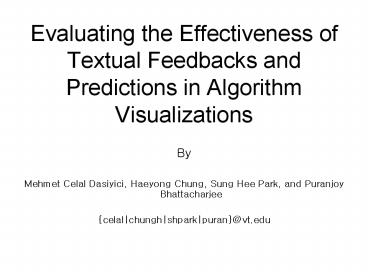Evaluating the Effectiveness of Textual Feedbacks and Predictions in Algorithm Visualizations - PowerPoint PPT Presentation
1 / 11
Title:
Evaluating the Effectiveness of Textual Feedbacks and Predictions in Algorithm Visualizations
Description:
Construct their own input dataset, make prediction, program the algorithm, and answer questions about the algorithm being visualized, construct their own ... – PowerPoint PPT presentation
Number of Views:42
Avg rating:3.0/5.0
Title: Evaluating the Effectiveness of Textual Feedbacks and Predictions in Algorithm Visualizations
1
Evaluating the Effectiveness of Textual Feedbacks
and Predictions in Algorithm Visualizations
- By
- Mehmet Celal Dasiyici, Haeyong Chung, Sung Hee
Park, and Puranjoy Bhattacharjee - celalchunghshparkpuran_at_vt.edu
2
Outline
- Introduction
- Engagement
- Motivation
- The Goal
- Experimental Design
- Versions of the AV
- Independent Dependent Variables
- Procedure
- Questionnaires
- Participant Recruitment Methods
- What to Do Next / Project Plan
3
The effectiveness of AV
- The effectiveness of AV
- It can be determined by its pedagogical values.
- Pedagogical values
- How much students learn about that algorithm by
using the AV? - How can we increase the pedagogical benefits of
using the AV? - Not what users see, but how they engage and
interact with the visualization increases the
effectiveness of an AV.
4
Engagement
- Engagement with AV can increase the pedagogical
value of the AV (Hundhausen et al. 2002) - Lack of significant improvement is often
attributable to the AV not actively engaging the
learners - Not what the users passively see, but how they
engage and interact with the visualization - Construct their own input dataset, make
prediction, program the algorithm, and answer
questions about the algorithm being visualized,
construct their own visualization
5
Motivation
- Prediction Make prediction about the next
algorithm steps - Our study is motivated by two studies Byrne el
al. 1996 and Jarc et al 2000. Both conducted
experiments to evaluate the benefit of
prediction - They failed to show significant impact of
predicting the next steps of the algorithm on the
learning outcomes. - Hypothesis being able to predict the next steps
of the algorithm would improve learning an
algorithm when it is coupled with the textual
feedback about each answer the user gives.
6
The goal
- Evaluate pedagogical effects of textual feedback
which is coupled with prediction process in the
AV - Define better ways of designing more effective
AVs - Increase pedagogical benefits of the usage of an
AV.
7
Experimental Design
- Between-subjects design crossing different
versions of an AV viewing an AV. - Independent Variables Versions of the AV
- (a) No textual feedback/no prediction,
- (b) Textual feedback/no prediction.
- (c) Textual feedback/prediction.
- Dependent Variables
- Post-test scores Pre-test scores
8
Experimental Design
- Procedure
- Pre-test
- Examine one version of the visualization.
- Post-test
- Population Virginia Tech students or Blacksburg
residents. (N10 for each version, N30 in total) - Prediction Users will have more performance
improvement when the level of engagement between
user and AV increases. - Algorithm Visualizations To Be Used We will use
hashing tutorials quadratic probing section in
our experiments.
9
Questionnaires
- Pre-test and post-test will be taken by
participant before and after treatment,
respectively. - Pre-test and post-test will be identical
questions. - 10 questions in each test two type of questions
- 4 easy questions (A question 1-4)
- 6 difficult questions(B question5-10)
- Some questions ask how to use a basic hash
function, in this evaluation, mod function(3, 6,
7). - Some questions ask how to use a collision
resolution method, in this evaluation, quadratic
probing (the rest of them) - 12 1,
- 22 2, 4, 5, 8
- 32 9
- 42 10
10
Participant recruiting methods
- Thirty students will participate in the study,
all volunteers and all undergraduate and graduate
students in computer science at Virginia Tech. - They had had little or no exposure to Hashing -
Quadratic probing topic, but all had taken either
undergraduate- or graduate-level algorithms
courses. - All records are private. Researchers will not use
any personal information, including name, email,
sex, age, etc. - Recruiting poster, department mailing lists, and
course mailing list will be used. - Recruiting poster and department mailing lists
will be used.
11
what to do/ plan































